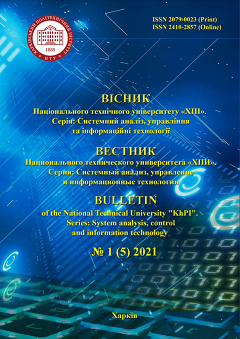ALGORITHMS AND SOFTWARE OF BUILDINGS INTERMITTENT THERMAL CONDITIONS OPTIMAL CONTROL
DOI:
https://doi.org/10.20998/2079-0023.2021.01.06Abstract
The actual problem of synthesizing the optimal control law for the intermittent heating mode of office buildings is considered, which consists in the programmed reduction of the room temperature during off-hours. The analysis of information sources showed the absence of sufficiently justified methods for solving the problem of optimizing the thermal processes of buildings, which provide comfortable conditions for the functioning of personnel, on the one hand, and save costs for buildings maintenance, on the other hand. The statement of the building thermal state optimal control problem is formulated, which contains a mathematical model of the process, a control goal, constraints on control actions and an integral quadratic quality criterion, including deviations of the room temperature from a given program and heat consumption. The limitation on the control action is taken into account by the method of penalty functions. As a mathematical model of the optimized thermal process, a two-dimensional controlled system of differential equations with constant coefficients is applied. The values of these coefficients are determined on the basis of building similarity criteria, which allows solving the optimization problem in a dimensionless form. The model includes a control action - the supplied heat flux, and a disturbing action - the ambient temperature, changing according to a given harmonious law. The numerical solution of the optimal control problem is implemented by the Chernous'ko method of successive approximations. A description of the user interface is given, as well as examples of the implementation of the thermal state optimal control. The proposed software allows on the stage of designing the heating system to obtain express assessments of various thermal modes of the building, and can also be used as computer support for automated individual heating points.
Keywords: intermittent heating mode, optimal control, mathematical model, control quality criterion, control constraints, penalty function, successive approximations, program interface, automated individual heating point.
References
Ceckinato L., Gastaldello A., Skibuola L. Sovremennaya sistema upravleniya temperaturnym rezhimom otaplivaemykh pomeshchenii [Modern control system for the temperature mode of heated rooms]. Energosberezhenie [Energy saving], 2007, no. 6, pp. 74– 78 p.
Tabunshchikov Yu. A., Brodach M. M. Matematicheskoe modelirovanie i optimizatsiya teplovoi effektivnosti zdanii [Mathematical modeling and optimization of thermal efficiency of buildings]. Moskva : AVOK-PRESS Publ., 2002. 194 p.
Panferov V. I., Anisimova E. Yu. Analiz vozmozhnosti ekonomii teplovoi energii pri preryvistom rezhime otopleniya [Analysis of the possibility of saving thermal energy with intermittent heating]. Vestnik YuUrGU. Seriya “Stroitel'stvo i arkhitektura” [Bulletin of SUSU. Series "Construction and Architecture"], 2008, issue 6, no 12, pp. 30–37.
Gershkovich V. F. O vozmozhnosti prakticheskoi realizatsii regulirovaniya teplopotrebleniya zdanii metodom periodicheskogo preryvaniya potoka teplonositelya [On the possibility of practical implementation of the regulation of heat consumption in buildings by the method of periodic interruption of the heat carrier flow.]. Novosti teplosnabzheniya [Heat supply news], 2000, no 10, pp. 16–23.
Vasil'ev G. P., Lichman V. A., Peskov N. V. Chislennyi metod optimizatsii preryvistogo rezhima otopleniya [Numerical optimization method for intermittent heating]. Matematicheskoe modelirovanie [Mathematical modeling], 2010, issue 22, no 11, pp. 123–130.
Kutsenko A. S., Kovalenko S. V., Tovazhnyanskyy V. I. Analiz energoeffektivnosti preryvistogo rezhima otopleniya zdaniya [Energy efficiency analysis of intermittent heating of a building]. Polzunovskii vestnik [Polzunovsky Bulletin]. Barnaul: Polzunov Altai State Technical University Publ., 2014, no 1. pp. 75–82.
Anisimova E. Yu. Energoeffektivnost' teplovogo rezhima zdaniya pri ispol'zovaniya optimal'nogo rezhima preryvistogo otopleniya [Energy efficiency of the thermal regime of the building using the optimal intermittent heating regime]. Vestnik YuUrGU. Seriya “Stroitel'stvo i arkhitektura” [Bulletin of SUSU. Series "Construction and Architecture"], 2017, no. 15, pp. 55–59.
Datsyuk T. A., Ivlev Yu. P., Pukhkal V. A. Modelirovanie teplovogo rezhima zhilykh pomeshchenii pri preryvistom otoplenii [Modeling the thermal mode of residential buildings with intermittent heating]. Sovremennye problemy nauki i obrazovaniya [Modern problems of science and education]. 2017, no 5. Available at: http://www.scienceeducation.ru/ru/article/view?id=14698 (accessed 10.04.2021).
Mishin M. A. Teplovoi rezhim zdanii [Thermal mode of buildings]. Polzunovskii vestnik [Polzunovsky Bulletin]. Barnaul: Polzunov Altai State Technical University Publ., 2011, no 1. pp. 104–115.
Kutsenko A. S., Tovazhnyanskyy V. I. Kombinirovannaya sistema avtomaticheskogo upravleniya teplovym sostoyaniem zdaniya s prognoziruyushchei model'yu [Combined system of automatic control of the thermal state of a building with a predictive model]. Vestnik Nats. tekhn. un-ta "KhPI": sb. nauch. tr. Temat. vyp.: Sistemnyy analiz, upravlenie i informatsionnye tekhnologii [Bulletin of the National Technical University "KhPI": a collection of scientific papers. Thematic issue: System analysis, management and information technology]. Kharkov, NTU "KhPI" Publ., 2017, no. 51 (1272), pp. 3–7.
Boltyanskii V. G. Matematicheskie metody optimal'nogo upravleniya [Optimal control mathematical methods]. Moscow: Nauka Publ., 1966. 308 p.
Chernous'ko F. L. Variatsionnye zadachi mekhaniki i upravleniya [Variational problems of mechanics and control]. Moscow: Nauka Publ., 1973. 238 p.
Downloads
Published
How to Cite
Issue
Section
License
LicenseAuthors who publish with this journal agree to the following terms:
- Authors retain copyright and grant the journal right of first publication with the work simultaneously licensed under a Creative Commons Attribution License that allows others to share the work with an acknowledgement of the work's authorship and initial publication in this journal.
- Authors are able to enter into separate, additional contractual arrangements for the non-exclusive distribution of the journal's published version of the work (e.g., post it to an institutional repository or publish it in a book), with an acknowledgement of its initial publication in this journal.
- Authors are permitted and encouraged to post their work online (e.g., in institutional repositories or on their website) prior to and during the submission process, as it can lead to productive exchanges, as well as earlier and greater citation of published work (See The Effect of Open Access).


